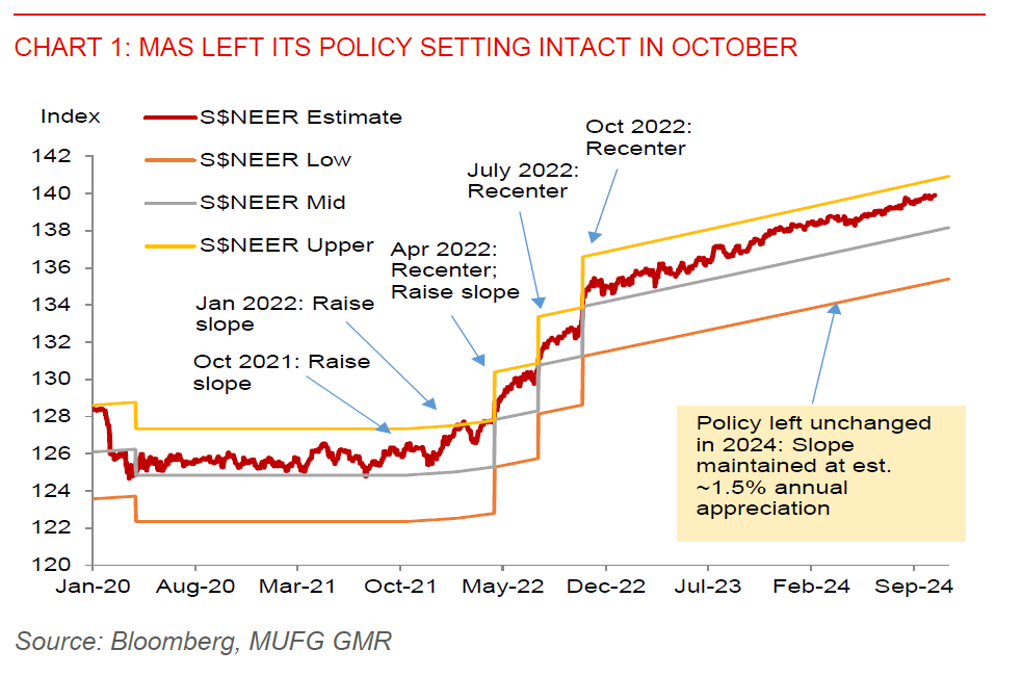Key Points
- In line with our and market expectations, the MAS left its monetary policy setting unchanged at its October quarterly meeting. The MAS is not in a hurry to loosen policy, with GDP growth picking up strongly to 2.1%qoq in Q3 from 0.4%qoq in Q2, while core inflation has remained above the central bank’s soft target of “under 2%”. There is no change to the slope, width, or level of the S$NEER policy band. For now, MAS assesses that the current policy setting remains consistent with medium-term price stability.
- We maintain our outlook for the MAS to start loosening its policy setting at the January 2025 meeting via reducing slightly the slope of the S$NEER (i.e. slightly reduce the pace of S$NEER appreciation). A key factor for our outlook is that Singapore’s core inflation is likely to step down significantly to slightly below 2%yoy in Q4, if the current 3m/3m sequential pace of core inflation is maintained. The 3m/3m core inflation momentum had slowed to just 0.2% (0.9% annualised) in August, reflecting a slower pace of price increases in food services and a range of retail and durable goods. The inflationary impact of the 1ppt GST hike will likely fade heading into 2025. The MAS estimates that core inflation excluding the impact of the GST hikes edged below 2% in the July-August period.
- Singapore’s labour market tightness has also been easing, which should help moderate wage growth containing cost-push inflation. The average monthly wage growth eased to 4.1%yoy in Q2 from 6.4%yoy in Q1. The recruitment rate fell to 1.97% in Q2, from 2.1% in Q1, reflecting easing hiring intentions, while the resignation rate was down to 1.32 from 1.39 in Q1. In addition, the domestic supply price index, which measures price changes of products retained for domestic use that are manufactured locally or imported - fell 3%yoy in August. MAS expects core inflation to average around 2% in 2025, while CPI-All items inflation to also average around 1.5%-2.5% next year.
- We believe the balance of risks for the MAS has shifted away from inflation towards growth. At the press conference, MAS seems to have adopted a more dovish tone in our view compared to its policy statement. Officials have appeared to be confident that the last mile of disinflation can be achieved in the coming months, which would warrant a dovish shift in policy stance.
- Advance estimates show GDP growth picked up to 2.1%qoq in Q3. From a year ago, GDP grew 4.1%, from 2.9% in Q2 and beating Bloomberg consensus of 3.8%yoy. The stronger than expected growth momentum was largely driven by electronics manufacturing, while activity also picked up in the modern services sector. We forecast Singapore’s GDP growth at 3.3% in 2024 and 2.9% in 2025, which is around the economy’s potential output growth. Key downside risks could stem from a significant downturn in the global economy or the global tech cycle, resulting from potentially onerous US tariffs or tech export restrictions if Trump wins the US presidential election this November.
- With the Fed set to cut interest rates further, which will limit US dollar strength, there's thus scope for Singapore rates (3m SORA) to continue to move lower through 2025. We maintain our forecast for the 3m SORA to end 2024 at 3.3% before declining further to 2.6% by end-2025.


